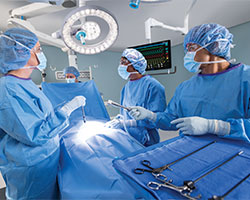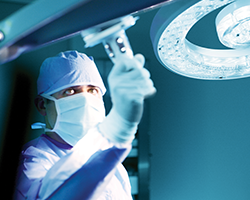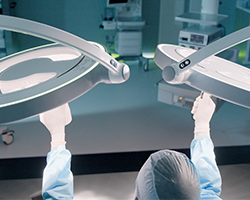Knowledge Center
June 23, 2020
Why is Operating Room Lighting Important?
By Lena Elias-Fogle, BSN RN, CNOR
Lena is a seasoned healthcare leader with extensive experience leading complex perioperative environments as well as new program development, continuous process improvement, clinical outcomes, operational excellence, and stakeholder experience.

In the Operating Room (OR), it is imperative that the surgical team has high-quality lighting to accurately and consistently assess and interpret internal anatomy of the patient during surgery. Having the right surgical lighting is critical for optimal patient safety and staff comfort, and creates a safe, comfortable and healing environment. High-quality light emitting diode (LED) surgical lights are designed to provide hours of bright light with natural color rendition, shadow control and deep-cavity illumination of the surgical site while not excessively heating the patient or staff. Poor lighting during a surgical procedure can lead to surgeon eye fatigue and may pose a risk to patient safety.
Medical Lighting Terminology
- Light Intensity – The rate at which light is delivered to a surface from a light source.
- Automatic Intensity Function – This function on a surgical light maintains the intensity when you move the lighthead further from or closer to the surgical site as well as when you increase or decrease the pattern size. With this feature, the light will adjust intensity for optimal performance automatically.
- Color Rendering Index (CRI) – Color rendering determines how well a light source reveals colors to the human eye. The best CRI light quality is 100, and ratings below zero are the poorest quality. An Operating Room lighting system with a high CRI rating should be selected for the most accurate visualization of anatomical structures.
- Kelvin – Kelvin refers to the color temperature of a light. A candle may have a color temperature of 1,900K, for example, while direct sunlight has 4,800K.
Types of Light Bulbs

- Halogen Lights: Halogen bulbs have been the standard for Operating Rooms for many years. They are brighter than incandescent bulbs and lights with halogen bulbs are often used for medical exams and surgeries. However, halogen bulbs emit more heat than LED bulbs and the light emitted tends to have a yellow tinge related to its color-correlated temperature (CCT).
- LED Lights: LED lighting is the new standard for surgical lights in the modern OR. LED bulbs offer much longer life, brighter whiter light, and less heat production. Advances in the last decades in LED technology now offer even more light production per LED. Each LED can produce up to 10 times the light previous generations have produced by integrating the light arrays and focusing the light in one direction.
Operating Room Lighting: The Key Factors
Mounting Configuration of Surgical Lights
The mounting and configuration choices are ones made with the intended purpose of the surgical suite in mind. In addition to lights, mounting configurations can include auxiliary arms for other equipment such as in-field monitors, radiation shields, and equipment booms. Lightweight suspension can assist in maneuverability of the arms. Systems that are upgradable, expandable, and modular offer the best flexibility for today’s needs as well as unknown needs in the future.
Shadow Control
Shadows cause a certain percentage of reduction in light during a procedure due to an obstruction, such as hands or heads of surgical staff members, or surgical instruments. Superior shadow control depends on strategically placed LED light bulbs within the surgical lighthead, multiple overlapping LEDs, and a design that allows for maximum central light. Most surgical lights have the handle positioned in the center of the light which precludes the ability to place LED lights in that area. An offset handle allows for more LEDs to be placed in the center of the lighthead, allowing better illumination of the deep cavities. It is general practice for most perioperative teams to position the surgical light directly over the operative site. To maximize lighting effectiveness, clinicians may find is beneficial to position one light at the head of the table and one light at the foot and point both lights laterally. In this position, it's possible to further reduce the effects of obstruction to the lighthead.

Heat Management
LED surgical lights emit significantly less heat than other types of lights. Surgical light heat can be measured in two places: the surgical site and the lighthead. An open design on a surgical lighthead allows heat to escape and surgical plume smoke to dissipate.
Illumination
Illuminance has often been referred to as “brightness,” but this can lead to confusion with other uses of the word. Brightness refers to non-quantitative perceptions of light. Illuminance is a quantitative measure of the amount of lux that is hitting the surface. For surgical lighting, this refers to the central illumination that is at the center of the lighting focal point measured one meter from the lighthead. Proper illumination is a compromise to ensure a good visibility with minimal glare and prevent eye strain for surgeons. The spot size can vary depending on the type of surgery to limit peripheral glare.
Surgical lights are critical for optimal patient safety and staff comfort. The quality of surgical light can have an impact on the quality and precision of work during a procedure. As the new standard in Operating Room lighting, LED lights emitting pure white light allow for accurate and consistent assessment.


